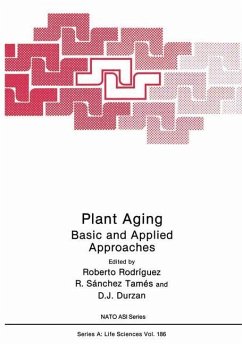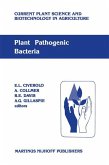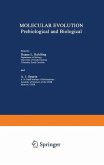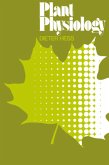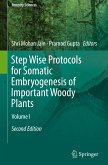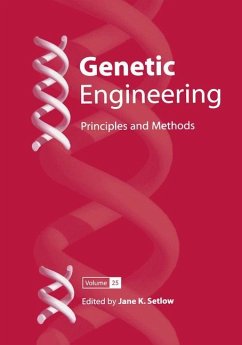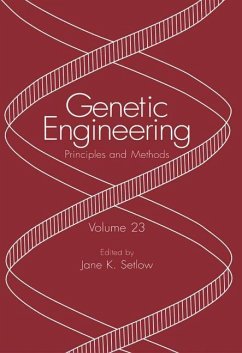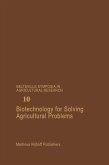Plant Aging
Basic and Applied Approaches
Herausgegeben:Rodríguez, Roberto; Tamés, R.Sanchez; Durzan, Dom J.
Plant Aging
Basic and Applied Approaches
Herausgegeben:Rodríguez, Roberto; Tamés, R.Sanchez; Durzan, Dom J.
- Broschiertes Buch
- Merkliste
- Auf die Merkliste
- Bewerten Bewerten
- Teilen
- Produkt teilen
- Produkterinnerung
- Produkterinnerung
For many, the terms aging, maturation and senescence are synonymous and used interchangeably, but they should not be. Whereas senescence represents an endogenously controlled degenerative programme leading to plant or organ death, genetiC aging encompasses a wide array of passive degenerative genetiC processes driven primarily by exogenous factors (Leopold, 1975). Aging is therefore considered a consequence of genetiC lesions that accumulate over time, but by themselves do not necessarily cause death. These lesions are probably made more severe by the increase in size and complexity in trees…mehr
Andere Kunden interessierten sich auch für
![Plant pathogenic bacteria Plant pathogenic bacteria]() Plant pathogenic bacteria229,99 €
Plant pathogenic bacteria229,99 €![Molecular Evolution Molecular Evolution]() Molecular Evolution39,99 €
Molecular Evolution39,99 €![Plant Physiology Plant Physiology]() D. HessPlant Physiology39,99 €
D. HessPlant Physiology39,99 €![Step Wise Protocols for Somatic Embryogenesis of Important Woody Plants Step Wise Protocols for Somatic Embryogenesis of Important Woody Plants]() Step Wise Protocols for Somatic Embryogenesis of Important Woody Plants75,99 €
Step Wise Protocols for Somatic Embryogenesis of Important Woody Plants75,99 €![Genetic Engineering Genetic Engineering]() Genetic Engineering75,99 €
Genetic Engineering75,99 €![Genetic Engineering Genetic Engineering]() Genetic Engineering77,99 €
Genetic Engineering77,99 €![Biotechnology for Solving Agricultural Problems Biotechnology for Solving Agricultural Problems]() Biotechnology for Solving Agricultural Problems153,99 €
Biotechnology for Solving Agricultural Problems153,99 €-
-
-
For many, the terms aging, maturation and senescence are synonymous and used interchangeably, but they should not be. Whereas senescence represents an endogenously controlled degenerative programme leading to plant or organ death, genetiC aging encompasses a wide array of passive degenerative genetiC processes driven primarily by exogenous factors (Leopold, 1975). Aging is therefore considered a consequence of genetiC lesions that accumulate over time, but by themselves do not necessarily cause death. These lesions are probably made more severe by the increase in size and complexity in trees and their attendant physiology. Thus while the withering of flower petals following pollination can be considered senescence, the loss of viability of stored seeds more clearly represents aging (Norden, 1988). The very recent book "Senescence and Aging in Plants" does not discuss trees, the most dominant group of plants on the earth. Yet both angiospermic and gymnospermic trees also undergo the above phenomena but less is known about them. Do woody plants senesce or do they just age? What is phase change? Is this synonymous with maturation? While it is now becoming recognized that there is no programmed senescence in trees, senescence of their parts, even in gymnosperms (e. g. , needles of temperate conifers las t an average of 3. 5 years), is common; but aging is a readily acknowledged phenomenon. In theory, at least, in the absence of any programmed senescence trees should -live forever, but in practice they do not.
Hinweis: Dieser Artikel kann nur an eine deutsche Lieferadresse ausgeliefert werden.
Hinweis: Dieser Artikel kann nur an eine deutsche Lieferadresse ausgeliefert werden.
Produktdetails
- Produktdetails
- Nato Science Series A: 186
- Verlag: Springer / Springer US / Springer, Berlin
- Artikelnr. des Verlages: 978-1-4684-5762-9
- Softcover reprint of the original 1st ed. 1990
- Seitenzahl: 468
- Erscheinungstermin: 26. Februar 2012
- Englisch
- Abmessung: 254mm x 178mm x 26mm
- Gewicht: 873g
- ISBN-13: 9781468457629
- ISBN-10: 1468457624
- Artikelnr.: 39506473
- Herstellerkennzeichnung
- Springer-Verlag GmbH
- Tiergartenstr. 17
- 69121 Heidelberg
- ProductSafety@springernature.com
- Nato Science Series A: 186
- Verlag: Springer / Springer US / Springer, Berlin
- Artikelnr. des Verlages: 978-1-4684-5762-9
- Softcover reprint of the original 1st ed. 1990
- Seitenzahl: 468
- Erscheinungstermin: 26. Februar 2012
- Englisch
- Abmessung: 254mm x 178mm x 26mm
- Gewicht: 873g
- ISBN-13: 9781468457629
- ISBN-10: 1468457624
- Artikelnr.: 39506473
- Herstellerkennzeichnung
- Springer-Verlag GmbH
- Tiergartenstr. 17
- 69121 Heidelberg
- ProductSafety@springernature.com
Section I: Aging, Maturation and Rejuvenation.- Aging of Meristems and Morphogenetic Potentialities.- Maturation and Senescence: Types of Aging.- Adult vs. Juvenile Explants: Directed Totipotency.- Recovery of Transient Juvenile Capacities During Micropropagation of Filbert.- Juvenility and Maturity of Woody Species in New Zealand.- Development of Rejuvenation Methods for "in vitro" Establishment, Multiplication and Rooting of Mature Trees.- Aging in Tree Species: Present Knowledge.- Section II: Vegetative Propagation: Advantages and Limitations.- Special Problems and Prospects in the Propagation of Woody Species.- Factors Affecting Tissue Culture Success in Mass Propagation.- Effective Handling of Plant Tissue Culture.- "In vitro" Micromultiplication of Grapevine: Effect of Age, Genotype and Culture Conditions on Induction of Callus in Vitis spp. Leaf Segments.- Plant Cells and Protoplast Immovilization as Tools for Studies on Cell Function, Metabolism and Differentiation.- Recovery of Somatic Variation in Resistance of Populus to Septoria Musiva.- Shoot-Tip Grafting "in vitro" of Woody Species and its Influence on Plant Age.- The Control by Cryopreservation of Age-Related Changes in Plant Tissue Culture.- Vitrification in Plant Tissue Culture.- Section III: Ultrastructural, Genetic and Biochemical Characteristic of Aging and Senescence.- The Molecular Genetics of Maturation in Eastern Larch (Larix laricina (Du Roi) K. Koch).- Cellular, Biochemical and Molecular Characteristics Related to Maturation and Rejuvenation in Woody Species.- Uptake Characteristics of Sugars and Amino Acids by Vitis vinifera L. Protoplasts.- Improvement of Micropropagation Methods Linked to Biochemical Properties During "in vitro" Cultures.- Age Dependence of DifferentComponents of Variance.- Interactions Between Genotype and Developmental Factors Modifying Peroxidase Expression.- Organogenesis: Structural, Physiological and Biochemical Aspects.- Changes in Carbohydrate Metabolism During Transient Senescence of Mustard (Sinapsis alba L.) Cotyledons.- Study of Gene Expression During "in vitro" Culture of Tobacco Thin Cell Layers by Two-Dimensional Electrophoresis of Proteins.- An Experimental Model for the Analysis of Plant Cell Differentiation: Thin Cell Layer Concept, Strategy, Methods, Records and Potantial.- Nutrient Remobilization, Nitrogen Metabolism and Chloroplast Gene Expression in Senescent Leaves.- Oxidative Stress and Senescence in Oat Leaves.- Structure and Function of Glutamate Dehydrogenase During Transient Senescence of Mustard (Sinapsis alba L.) Cotyledons.- Section IV: Modulation of Aging and Maduration.- Effects of Vascular Tissue Containing a Meristem of Adjacent Pith: Hormone-Like Factors.- Hormonal Control of Senescence.- Modulation, Purification and Function of a Soluble Auxin Receptor.- Free Radicals in Stressed and Aging Plant Tissue Cultures.- Polyamines and Aging: Effect of Polyamine Biosynthetic Inhibitors on Plant Regeneration in Maize Callus Cultured "in vitro".- Hormone Action and Sensitivity: Possible Relation to Aging.- Section V: Genetic Manipulation.- Cellular and Morphogenic Reorientation Induced by Inserting Foreing DNA.- Genetic Manipulation of Forest Trees: Implications for Physiological Processes.- Biotechnology in Forest Tree Improvement: Trees of the Future.- Biotechnology in Forest Tree Improvement: Trees of the Future.- Selected Posters.- Micropropagation of Vitis vinifera from "Vinho Verde" Region of Portugal: A Method for Grapevine Leafroll Virus Elimination.- "In vitro"Culture of Pistacia vera L. Embryos and Aged Trees Explants.- Tissues Culture and Regeneration in Jojoba.- Effect of Cold Temperature on Shoot Regeneration "in vitro" From Aged Cultures of GF-677 (Prunus persica × Prunus amygdalus).- Age and Meristem "in vitro" Culture Behaviour in Filbert.- Influence of Explant Source on "in vitro" Axillary Shoot Formation in Oak (Quercus robur L.) Seedlings.- Segmentation Effect of Immature Spike on Triticale Calli Induction.- Cuticle Development in Dianthus caryophyllus Plantlets.- Partial "Rejuvenation" of 20-Year-Old Sitka Spruce by Lower Crown Pruning.- Phase Change in Seqoiadendron giganteum.- Rejuvenation of Adult Specimens of Castanea sativa Mill: Through "in vitro" Micropropagation.- Embryogenic Cultures of Tobacco Pollen as a Model System To Study Plant Rejuvenation.- The Meristematic Calli of Maize: A Maintenance System of Tissue Juvenility.- Growth and Development "in vitro" Long Term Cultures.- Protein Patterns on Corylus avellana L. Rooting Capacity.- Inducing Artificial Tetraploids from Diploid Meadow Fescue (Festuca pratensis Huds.) Varieties and the Investigation of Some Meiotic Characteristics of Them.- Inactivation of Peroxidase. Its Role in Plant Senescence.- Electron Microscope Observations and BA Effects in Apple Cells.- Polyamine and Ethylene Metabolisms During Tomato Fruit Ripening.- Levels of Cytokinins in Aging and Rejuvenated Corylus avellana L. Tissues.- Changes in Polyamines Related With Pruning As a Method for Rejuvenation in Filbert.- Early Flowering in Seedlings of Asparagus Promoted by Diuron and Atrazine.- Epilogue.
Section I: Aging, Maturation and Rejuvenation.- Aging of Meristems and Morphogenetic Potentialities.- Maturation and Senescence: Types of Aging.- Adult vs. Juvenile Explants: Directed Totipotency.- Recovery of Transient Juvenile Capacities During Micropropagation of Filbert.- Juvenility and Maturity of Woody Species in New Zealand.- Development of Rejuvenation Methods for "in vitro" Establishment, Multiplication and Rooting of Mature Trees.- Aging in Tree Species: Present Knowledge.- Section II: Vegetative Propagation: Advantages and Limitations.- Special Problems and Prospects in the Propagation of Woody Species.- Factors Affecting Tissue Culture Success in Mass Propagation.- Effective Handling of Plant Tissue Culture.- "In vitro" Micromultiplication of Grapevine: Effect of Age, Genotype and Culture Conditions on Induction of Callus in Vitis spp. Leaf Segments.- Plant Cells and Protoplast Immovilization as Tools for Studies on Cell Function, Metabolism and Differentiation.- Recovery of Somatic Variation in Resistance of Populus to Septoria Musiva.- Shoot-Tip Grafting "in vitro" of Woody Species and its Influence on Plant Age.- The Control by Cryopreservation of Age-Related Changes in Plant Tissue Culture.- Vitrification in Plant Tissue Culture.- Section III: Ultrastructural, Genetic and Biochemical Characteristic of Aging and Senescence.- The Molecular Genetics of Maturation in Eastern Larch (Larix laricina (Du Roi) K. Koch).- Cellular, Biochemical and Molecular Characteristics Related to Maturation and Rejuvenation in Woody Species.- Uptake Characteristics of Sugars and Amino Acids by Vitis vinifera L. Protoplasts.- Improvement of Micropropagation Methods Linked to Biochemical Properties During "in vitro" Cultures.- Age Dependence of DifferentComponents of Variance.- Interactions Between Genotype and Developmental Factors Modifying Peroxidase Expression.- Organogenesis: Structural, Physiological and Biochemical Aspects.- Changes in Carbohydrate Metabolism During Transient Senescence of Mustard (Sinapsis alba L.) Cotyledons.- Study of Gene Expression During "in vitro" Culture of Tobacco Thin Cell Layers by Two-Dimensional Electrophoresis of Proteins.- An Experimental Model for the Analysis of Plant Cell Differentiation: Thin Cell Layer Concept, Strategy, Methods, Records and Potantial.- Nutrient Remobilization, Nitrogen Metabolism and Chloroplast Gene Expression in Senescent Leaves.- Oxidative Stress and Senescence in Oat Leaves.- Structure and Function of Glutamate Dehydrogenase During Transient Senescence of Mustard (Sinapsis alba L.) Cotyledons.- Section IV: Modulation of Aging and Maduration.- Effects of Vascular Tissue Containing a Meristem of Adjacent Pith: Hormone-Like Factors.- Hormonal Control of Senescence.- Modulation, Purification and Function of a Soluble Auxin Receptor.- Free Radicals in Stressed and Aging Plant Tissue Cultures.- Polyamines and Aging: Effect of Polyamine Biosynthetic Inhibitors on Plant Regeneration in Maize Callus Cultured "in vitro".- Hormone Action and Sensitivity: Possible Relation to Aging.- Section V: Genetic Manipulation.- Cellular and Morphogenic Reorientation Induced by Inserting Foreing DNA.- Genetic Manipulation of Forest Trees: Implications for Physiological Processes.- Biotechnology in Forest Tree Improvement: Trees of the Future.- Biotechnology in Forest Tree Improvement: Trees of the Future.- Selected Posters.- Micropropagation of Vitis vinifera from "Vinho Verde" Region of Portugal: A Method for Grapevine Leafroll Virus Elimination.- "In vitro"Culture of Pistacia vera L. Embryos and Aged Trees Explants.- Tissues Culture and Regeneration in Jojoba.- Effect of Cold Temperature on Shoot Regeneration "in vitro" From Aged Cultures of GF-677 (Prunus persica × Prunus amygdalus).- Age and Meristem "in vitro" Culture Behaviour in Filbert.- Influence of Explant Source on "in vitro" Axillary Shoot Formation in Oak (Quercus robur L.) Seedlings.- Segmentation Effect of Immature Spike on Triticale Calli Induction.- Cuticle Development in Dianthus caryophyllus Plantlets.- Partial "Rejuvenation" of 20-Year-Old Sitka Spruce by Lower Crown Pruning.- Phase Change in Seqoiadendron giganteum.- Rejuvenation of Adult Specimens of Castanea sativa Mill: Through "in vitro" Micropropagation.- Embryogenic Cultures of Tobacco Pollen as a Model System To Study Plant Rejuvenation.- The Meristematic Calli of Maize: A Maintenance System of Tissue Juvenility.- Growth and Development "in vitro" Long Term Cultures.- Protein Patterns on Corylus avellana L. Rooting Capacity.- Inducing Artificial Tetraploids from Diploid Meadow Fescue (Festuca pratensis Huds.) Varieties and the Investigation of Some Meiotic Characteristics of Them.- Inactivation of Peroxidase. Its Role in Plant Senescence.- Electron Microscope Observations and BA Effects in Apple Cells.- Polyamine and Ethylene Metabolisms During Tomato Fruit Ripening.- Levels of Cytokinins in Aging and Rejuvenated Corylus avellana L. Tissues.- Changes in Polyamines Related With Pruning As a Method for Rejuvenation in Filbert.- Early Flowering in Seedlings of Asparagus Promoted by Diuron and Atrazine.- Epilogue.

